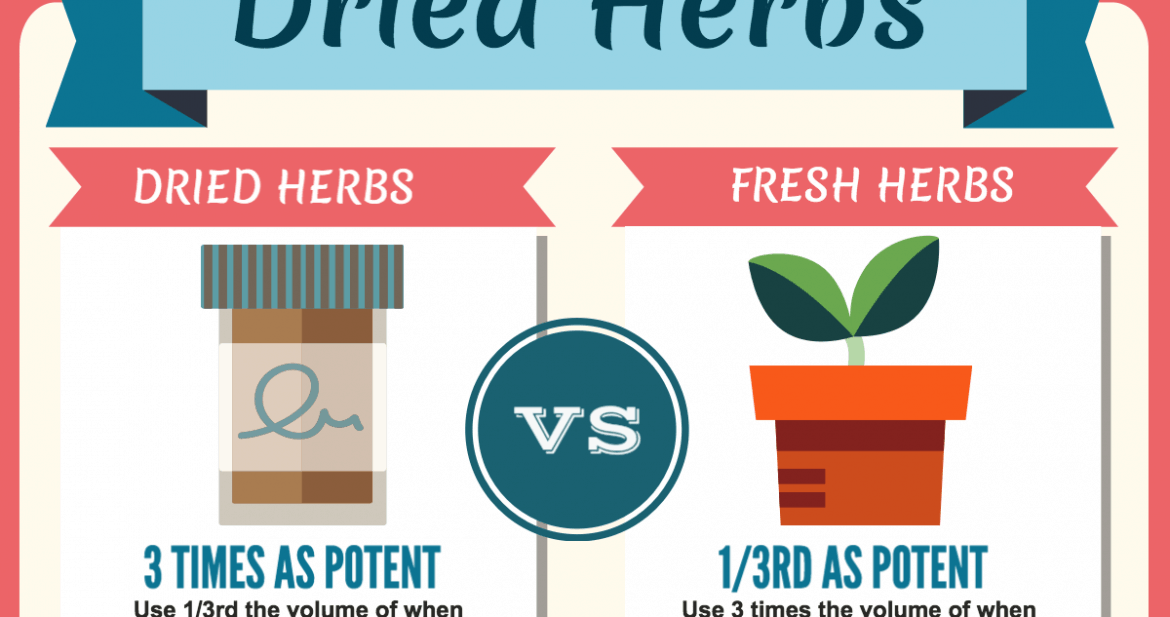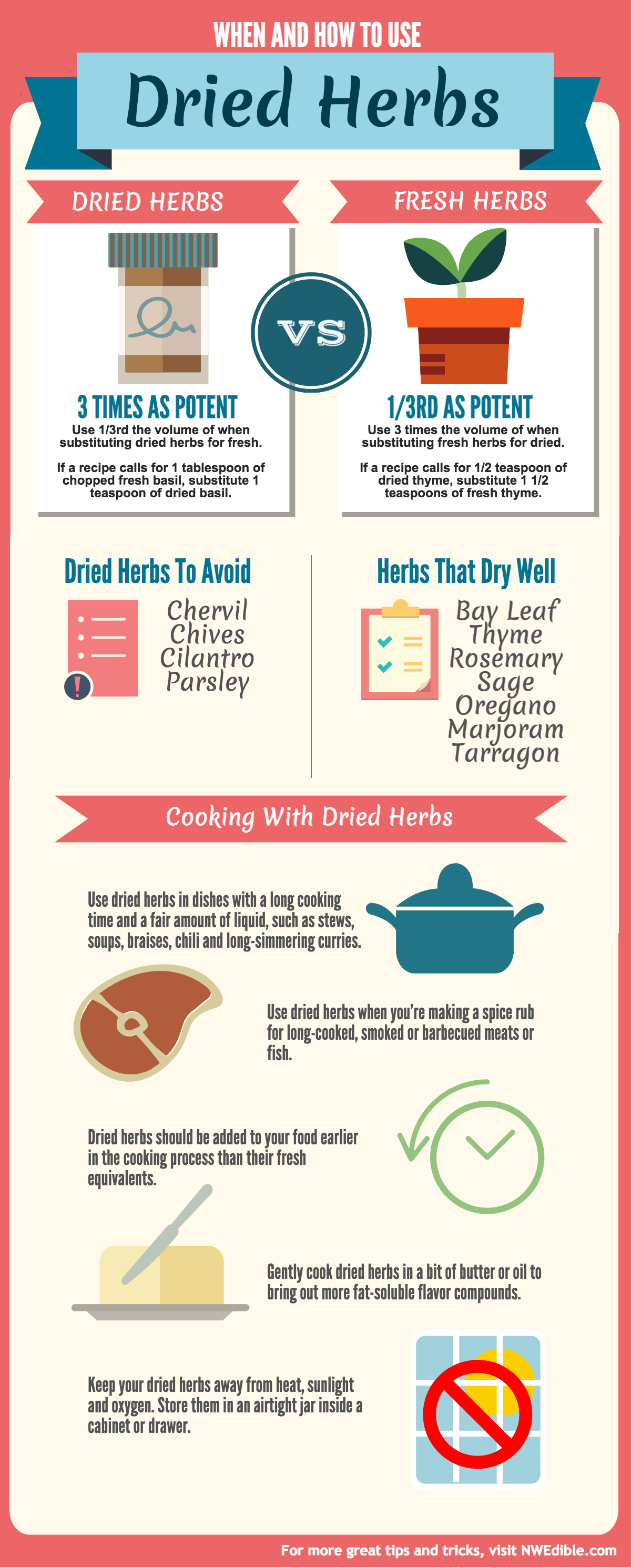Look, I’m pro-fresh-herb. I love giant huge bunches of cilantro, I consider it a crime that parsley isn’t used as a vegetable, I’ll drink chimichurri sauce by the shot glass. Who has two thumbs and loves fresh herbs? This girl.
And yet – there is a place for dried herbs. Usually, that place involves a big pot of stew, a glass of red wine and slippers. Let’s explore.
Basic Dried Herb Substitution Rules
Use 1/3rd the volume when substituting dried herbs for fresh.
- If a recipe calls for 1 tablespoon of chopped fresh basil, substitute 1 teaspoon of dried basil.
Going the other direction?
Use 3 times the volume when substituting fresh chopped herbs for dried.
- If a recipe calls for 1/2 teaspoon dried thyme, use 1 1/2 teaspoons fresh thyme.
Dried Herbs To Avoid
The flavor of all herbs changes somewhat when dried. But some herbs lose so much flavor when dried that they just aren’t worth using. These include:
- Chervil
- Chives
- Cilantro
- Parsley
Parsley, in particular, loses everything that makes it wonderful when subjected to dehydration. It’s also easy to grow and buy nearly year-round, so there’s really no excuse for dried parsley.
When a recipe calls for any of these fresh herbs, consider substituting something else, rather than reaching to the dried equivalent. For example, if a recipe calls for fresh chives but you don’t have any, don’t use dried chives. Dried chives suck. Instead, substitute green onions or finely minced shallot for a similar allium-vibe.
Dried Herbs That Aren’t That Bad
Fresh-herb-only purists don’t like to admit it, but some herbs hold their own quite well when dried. My most used dried herbs are:
- Bay Leaf
- Thyme
- Rosemary
- Sage
- Oregano
- Marjoram
- Tarragon
Now the great irony is that nearly all of these herbs are hardy enough to hold up all winter long in my Zone 7B/8A garden, so drying them can be a bit unnecessary. But I’ll be honest – in winter, sometimes I just don’t want to go tromping around cutting fresh thyme. I want to stay inside with my slippers on. So, dried thyme it is.
Tarragon is a bit controversial – you’ll see people saying it should be on the list above, the forbidden list. I disagree. I grow French Tarragon, and when dried gently it maintains a wonderful licoricey pungency. However, it’s delicate and does lose it’s flavor quickly. My advice? Grow your own or buy small amounts in bulk from someplace with a good, brisk herb and spice turnover.
Know When To Add Herbs
Dried herbs perform best in dishes with a long cooking time and a fair amount of liquid where they will simmer and rehydrate for some time. Dishes like stew, soups, braises, chili and long-simmering curries tend to do well with dried herbs.
Dried herbs are also a superior choice to fresh when you’re making a spice rub for long-cooked, smoked or barbecued meats or fish.
Most dried herbs should be added to your dish earlier in the cooking process than their fresh equivalents would be. This is especially true for leafy green herbs like basil, mint and oregano, which are nearly always added at the very end of cooking when fresh.
For the best flavor, consider briefly cooking dried herbs in a small amount of butter or oil to help bring out the fat-soluble flavor compounds before adding the herbs and cooking fat to the dish. (This is called “blooming” the herbs.) If your dish also includes spices, you should be doing this anyway – feel free to bloom the dried herbs and spices together.
One Last Thing
Dried herbs lose potency quickly, especially if stored where they are exposed to heat, sunlight, or oxygen. Keep your dried herbs in good shape longer by storing them in an airtight jar inside a cabinet or drawer. On the counter next to your stove might be convenient, but it’s a terrible place to store your dried herbs.
(Read more: How I store my herbs and spices.)


This is a great post. I like the lists of use-dried and avoid-dried in particular. I am pretty sure the infographic should use ‘potent’ rather than ‘potant’, although I’m not a spelling expert.
Fixed! Thank you!
I don’t know if this is feasible, but it seems to me that if your switched the locations of “dried herbs to avoid” and “herbs to dry well” you would have lists of things that you can use dried right under the info about using dried, and vice versa.
Sorry, I missed a career as a copy editor.
Rats. Just when I had dehydrated several large batches of parsley. I think I will add it to the dehydrated kale. It might still add some flavour and I won’t be wasting all those precious vitamins. But hey, great post. Is this information in The Book too? It is on the way.
Also, dried herbs are good in salad dressings you make ahead and/or keep. You know, because of that botulism-in-oil thing…
And parsley/cilantro can be preserved by freezing in a cube of oil/butter, if you have a bunch. Just pop the cube into the skillet and–poof–instant goodness.
Lastly, Erica, what software do you use for the infographics, if I may ask? (Off-topic, I know…)
Adorable infographic. I love it! Agreed on the cilantro and parsley, I’ve dried them in the past and asked myself why do I bother? They add zero flavor dried. But you nailed it on the rosemary. Dried or fresh, it totally works. Oregano, bay leaf and thyme have worked well for me in the past as well. Nifty post Erica!! All great reminders. Ok, I’m going to nag myself to dry my herbs this week. (I was going to skip this year!)
Great article! I really don’t use dry herbs as a rule (except bay) but now I am more informed!